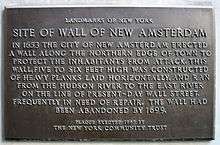Fortifications of New Netherland
| New Netherland series |
|---|
| Exploration |
| Fortifications: |
| Settlements: |
| The Patroon System |
|
| People of New Netherland |
| Flushing Remonstrance |
 |


New Netherland, or Nieuw-Nederland in Dutch, was the 17th century colony of the Republic of the Seven United Netherlands on the northeastern coast of North America. The claimed territory included southern Cape Cod to parts of the Delmarva Peninsula. Settled areas are now part of the Mid-Atlantic states of New York, New Jersey, Connecticut, Delaware and Pennsylvania. Its capital, New Amsterdam, was located at the southern tip of the island of Manhattan on Upper New York Bay.
Explored in 1609 by Henry Hudson while sailing on an expedition for the Dutch East India Company, the region was later surveyed, charted and given its name in 1614. The Dutch named the three main rivers of the province the Zuyd Rivier or "South River", the Noort Rivier or "North River", and the Versche Rivier or "Fresh River", and intended to use them to gain access to the interior, to the Native Americans and to the lucrative fur trade.
International law required not only discovery and a charter, but also the founding of forts and villages to confirm a territorial claim. Large-scale settlements were rejected by the Dutch in favor of the factorijen, a trading post with soldiers and a small group of settlers. During the first decade the New Netherland Company built Fort Nassau in Mahican/Mohawk territory on the North River. Among the places it is believed factorijen were set up are Schenectady, Schoharie, Esopus, Rodenbergh, Communipaw, Ninigret, and Manhattan.
The Dutch West India Company (WIC) was granted a charter by the Republic of the Seven United Netherlands on June 3, 1621,[1] forming a joint venture to exploit trade in New Netherland. The first settlers landed on Noten Island in 1624 and began the fortification and population of the colony. The names Fort Nassau and Fort Orange were used by the Dutch in the 17th century for several fortifications around the world in honor of the House of Orange-Nassau.
New Sweden was first settled in 1637 on territory claimed by the Dutch Republic, which was unable to prevent the incursion and did not officially recognize the colony. It was brought under Dutch control in a military expedition led by Director-General of New Netherland Peter Stuyvesant in 1655.[2] In that year the government enacted regulations requiring settlers throughout the province to construct stockades[3] to which they could withdraw if attacked, the most extensive being at Wiltwyck.
Dutch forts
- Fort Nassau (1614), on the North River (at Albany, New York), lost to floods
- Fort Orange (1624), Castle Island in the North River (at Albany, New York)
- Fort Amsterdam (1625), the Manhattoes harbor at the mouth of the North River (at the site of Alexander Hamilton U.S. Custom House)
- Fort Wilhelmus (1625), on the South River (at Burlington Island), soon abandoned[4]
- Fort Nassau (ca. 1627), near the South River (at Gloucester City, New Jersey), relocated 1651, becoming Fort Casimir
- Fort Huis de Goede Hoop (1633), on the Park River near the Fresh River (at Hartford)
- Fort Casimir (1651), on the South River (at New Castle, Delaware), briefly known as Fort Trefaldigheets (1654–1655) and later New Amstel
- Fort Beversreede (1651), on the Schuylkill River (at Southwest Philadelphia) near the South River
- Fort Altena (1655), the name given to Fort Christina (at Wilmington)
Swedish forts
- Fort Christina (1638) - at the Brandywine Creek and Christina River in Wilmington, Delaware, later renamed Fort Altena (1655)[5]
- Fort Mecoponacka (1641) - in Chester, near Finlandia or Upland in Delaware County, Pennsylvania[6]
- Fort Nya Elfsborg (1643) - between present-day Salem Creek and Alloway Creek near Bridgeport, New Jersey[7]
- Fort Nya Gothenborg (1643) - on Tinicum Island near the site of The Printzhof in Essington, Delaware County, Pennsylvania[8]
- Fort Nya Vasa (1646) - at Kingsessing, on the eastern-side of Cobbs Creek in Philadelphia[9]
- Fort Nya Korsholm (1647) - on the Schuylkill River near the South River in Philadelphia [10]
Other fortifications
- Noten Eylandt (1624), now Governors Island in New York Harbor
- Fort Ninigret (c.1637), on the mainland across from Dutch Island (Rhode Island) in Rhode island
- Roodenburg (c.16??), possibly a fort or factorij at the mouth of the Quinnipiac River[11]
- De Wal (1653), a wooden palisade or rampart, now Wall Street[12]
- The Rondout (1657) at Rondout Creek near the North River, at Wiltwijk [13]
- Bergen Square, (1661) atop Bergen Hill[14]
- Gravesend, Brooklyn
See also
References
- ↑ http://avalon.law.yale.edu/17th_century/westind.asp: Charter of the West India Company
- ↑ dead link State of Delaware (A Brief History). State of Delaware, 2007-01-21.
- ↑ Laws and Ordinances of New Netherland 1638-1674, compiled and translated by E.B. Callaghan, 1868
- ↑ Bert van Steeg,Walen in de Wildernis : Bij aankomst in de kolonie werden de kolonisten opgesplitst in vier groepen en werden er op een aantal plaatsen kleine vestigingen gesticht, vooral in de buurt van de al bestaande handelsposten. Een aantal families werden gevestigd aan de Delaware. Hier werd fort Wilhelmus gesticht. Twee families en zes mannen werden naar de Connecticut rivier gestuurd. Ook op Governors’ eiland werden een aantal kolonisten geplaatst om een fort te bouwen. Het grootste aantal kolonisten, onder wie Catalina Rapalje, werd echter net ten zuiden van het huidige Albany geplaatst. May liet hier een klein fort bouwen dat de naam Fort Orange kreeg. Hier verbleven ongeveer achttien families.[30] Brodhead, J.R., History of the state of New York (New York, 1871), pp.150-191.
- ↑ The Swedish Settlements on the Delaware 1638-1664 Volume I (Amandus Johnson Reprint Services Corp. 1911)
- ↑ Narratives of Early Pennsylvania, West New Jersey and Delaware 1630-1707 (ed. Albert Cook Myers. New York: Charles Scribner's Sons. 1912)
- ↑ The Swedes and Finns in New Jersey (Federal Writers' Project of WPA. Bayonne, New Jersey: Jersey Printing Company, Inc. 1938)
- ↑ History of Delaware County, Pennsylvania, by Henry Graham Ashmead. Philadelphia: L. H. Everts & Co. 1884
- ↑ Kingsessing: Swedish Settlement to Urban Blight, Elizabeth D. Day, University Archives and Records Center. University of Pennsylvania, 10 October 2005)
- ↑ History of Delaware County, Pennsylvania, Henry Graham Ashmead. Philadelphia: L. H. Everts & Co. 1884
- ↑ http://www.publicbookshelf.com/public_html/Our_Country_Vol_1/newhaven_fc.html
- ↑ Timeline: A selected Wall Street chronology. PBS Online, 21 October 2004. Retrieved 11 January 2009
- ↑ http://www.nps.gov/nr/travel/kingston/colonization.htm
- ↑